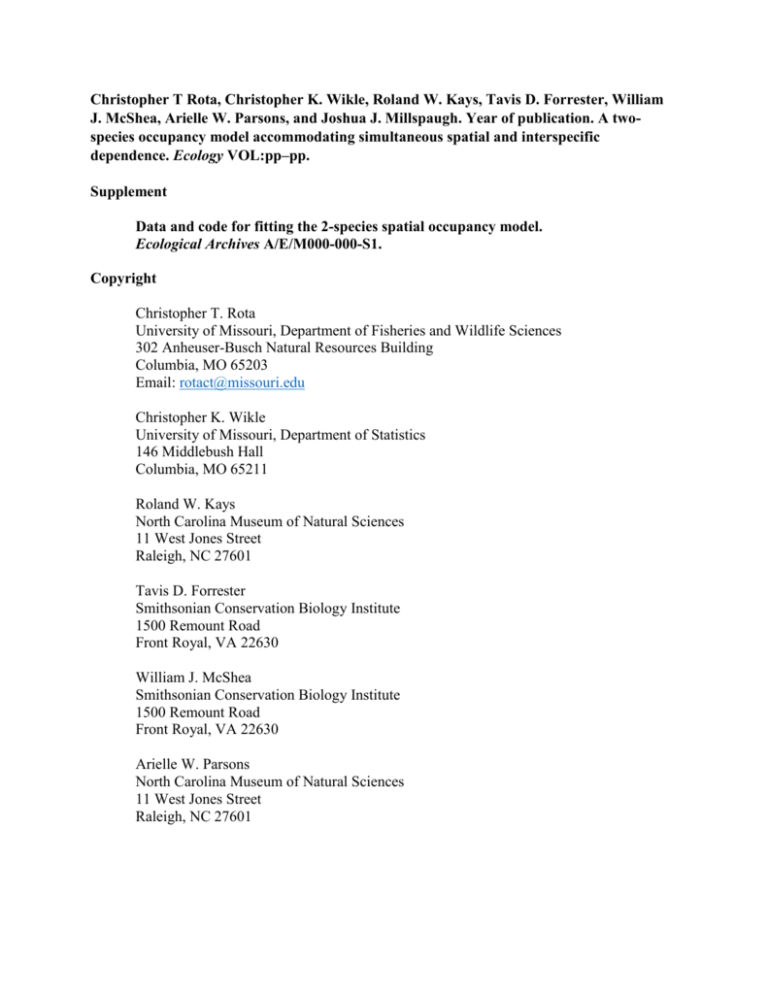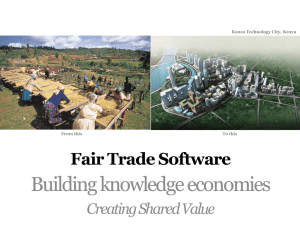ecy1226-sup-0008-Supinfo
advertisement

Christopher T Rota, Christopher K. Wikle, Roland W. Kays, Tavis D. Forrester, William J. McShea, Arielle W. Parsons, and Joshua J. Millspaugh. Year of publication. A twospecies occupancy model accommodating simultaneous spatial and interspecific dependence. Ecology VOL:pp–pp. Supplement Data and code for fitting the 2-species spatial occupancy model. Ecological Archives A/E/M000-000-S1. Copyright Christopher T. Rota University of Missouri, Department of Fisheries and Wildlife Sciences 302 Anheuser-Busch Natural Resources Building Columbia, MO 65203 Email: rotact@missouri.edu Christopher K. Wikle University of Missouri, Department of Statistics 146 Middlebush Hall Columbia, MO 65211 Roland W. Kays North Carolina Museum of Natural Sciences 11 West Jones Street Raleigh, NC 27601 Tavis D. Forrester Smithsonian Conservation Biology Institute 1500 Remount Road Front Royal, VA 22630 William J. McShea Smithsonian Conservation Biology Institute 1500 Remount Road Front Royal, VA 22630 Arielle W. Parsons North Carolina Museum of Natural Sciences 11 West Jones Street Raleigh, NC 27601 Joshua J. Millspaugh University of Missouri, Department of Fisheries and Wildlife Sciences 302 Anheuser-Busch Natural Resources Building Columbia, MO 65203 File List Directions for fitting the model.pdf Adaptive Function.R countdown.R Coyote.csv Format Data.R Gibbs Sampler.R Knot Alt.csv Model.R p covariates.csv psi covariates.csv Red Fox.csv Training Logical.csv Description Directions for fitting the model.pdf – describes the order in which .R files should be opened and executed Adaptive Function.R – a function for tuning the parameters of the proposal distribution necessary in the Metropolis Hastings step countdown.R – a function to indicate how much time remains to run the Gibbs sampler Coyote.csv – detection / non-detection data of Coyote at all sites. Each row is a site and each column is a detection / non-detection survey. Values of 0 indicate nondetection, values of 1 indicate detection, and blank cells indicate no survey was conducted. Format Data.R – a script to read and format data to be subsequently supplied to the Gibbs sampler Gibbs Sampler.R – executes the Gibbs sampler as described in Appendix B Knot Alt.csv – indicates which sites are treated as knots. Each row corresponds to a site. Values of TRUE indicate a site is treated as a knot, values of FALSE indicate a site is not treated as a knot. Model.R – reads and executes all of the functions, determine how many simulations to conduct, and prepare posterior simulations for post-processing p covariates.csv – site-specific covariates for the detection model. Each row is a site. Column “Camsite” is a unique identifier; “Latitude” and “Longitude” are latitude and longitude in decimal degrees / 100; “Park_ID” identifies the park or protected are a camera is located in; “Det_dist” is the maximum detection distance in meters of the camera trap. psi covariates – site-specific covariates for occupancy model. Each row is a site. Column “Camsite” is a unique identifier; “Latitude” and “Longitude” are latitude and longitude in decimal degrees / 100; “HDens_5k” is the housing density within a 5km radius, in units of houses × km-2; “Trail” is an indicator of whether a camera is on (=1) or off (=0) a trail; “Park_ID” identifies the park or protected are a camera is located in; “Hunting” in an indicator of whether a camera is located in a park or protected area that allows hunting; “People_site” is the total number of people detected at a site / 1,000. Red Fox.csv – detection / non-detection data of Red Fox at all sites. Each row is a site and each column is a detection / non-detection survey. Values of 0 indicate nondetection, values of 1 indicate detection, and blank cells indicate no survey was conducted. Training Logical.csv – Each row corresponds to a site. Values of TRUE indicate a site is a training site, values of FALSE indicate a site is a validation site.
![[#DTC-130] Investigate db table structure for representing csv file](http://s3.studylib.net/store/data/005888493_1-028a0f5ab0a9cdc97bc7565960eacb0e-300x300.png)










